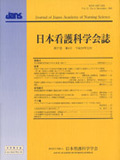Japanese
English
- 販売していません
- Abstract 文献概要
- 参考文献 Reference
- サイト内被引用 Cited by
要旨
目的:本研究は,転倒により大腿骨頚部骨折を受傷し,観血的治療を受けて自宅退院した高齢者の日常生活における再転倒に対する対処行動について明らかにすることを目的とした.
方法:エスノグラフィーを用いた.データは,病院から自宅退院して3カ月から1年程度経過している65歳以上の高齢者18名を対象に,半構成的面接と参加観察より収集した.
結果:再転倒に対する対処行動として6つのカテゴリーが見出された.【今度転んだら寝たきりだ】は,再転倒に対する対処行動の根底にあるのもとして位置付けられ,他の対処行動に作用していた.また,転倒原因に対する対処行動である【ふらつく身体を安定させる】と【転びやすいところは避ける】,日常生活活動における対処行動である【自信のない行動はしない】と【自分なりに転倒しない工夫をする】が見出された.【周りの支えを求める】は,これら4つの対処行動に作用していた.
結論:以上より,再転倒予防に取り組む彼らの積極的な姿勢は,転倒予防や介護予防に活かしていくことができると考える.
Abstract
Objective: The purpose of this study was to clarify coping behavior regarding risk of further fall for elderly patients who had been discharged home after undergoing open reduction of hip fracture sustained in a fall.
Methods: An ethnographic approach was used throughout this study. Data were obtained from semi-structured interview with eighteen elderly patients aged 65 years and older who were discharged from hospital 3 months to one year previously.
Results: Six categories of coping behavior related to risk of repeat fall were identified. “If I fall again, I will be bed-ridden” was characterized as the factor underlying coping behavior related to risk of falling again and this had a major influence on other coping behaviors. Coping behaviors aimed at eliminating the cause of falls “I stabilize my body when it is unstable” and “I avoid going to places where I might fall,” and coping behaviors related to daily activities “I do not act when I do not have confidence in my movements” and “I try to devise some method so that I do not fall” were identified. “I ask for help from others” influenced the four abovementioned behaviors.
Conclusions: It was concluded that the positive attitude of these patients towards prevention of a further fall could be utilized in prevention of falls and in reducing the number of elderly who might be in need of care.
Copyright © 2007, Japan Academy of Nursing Science. All rights reserved.


